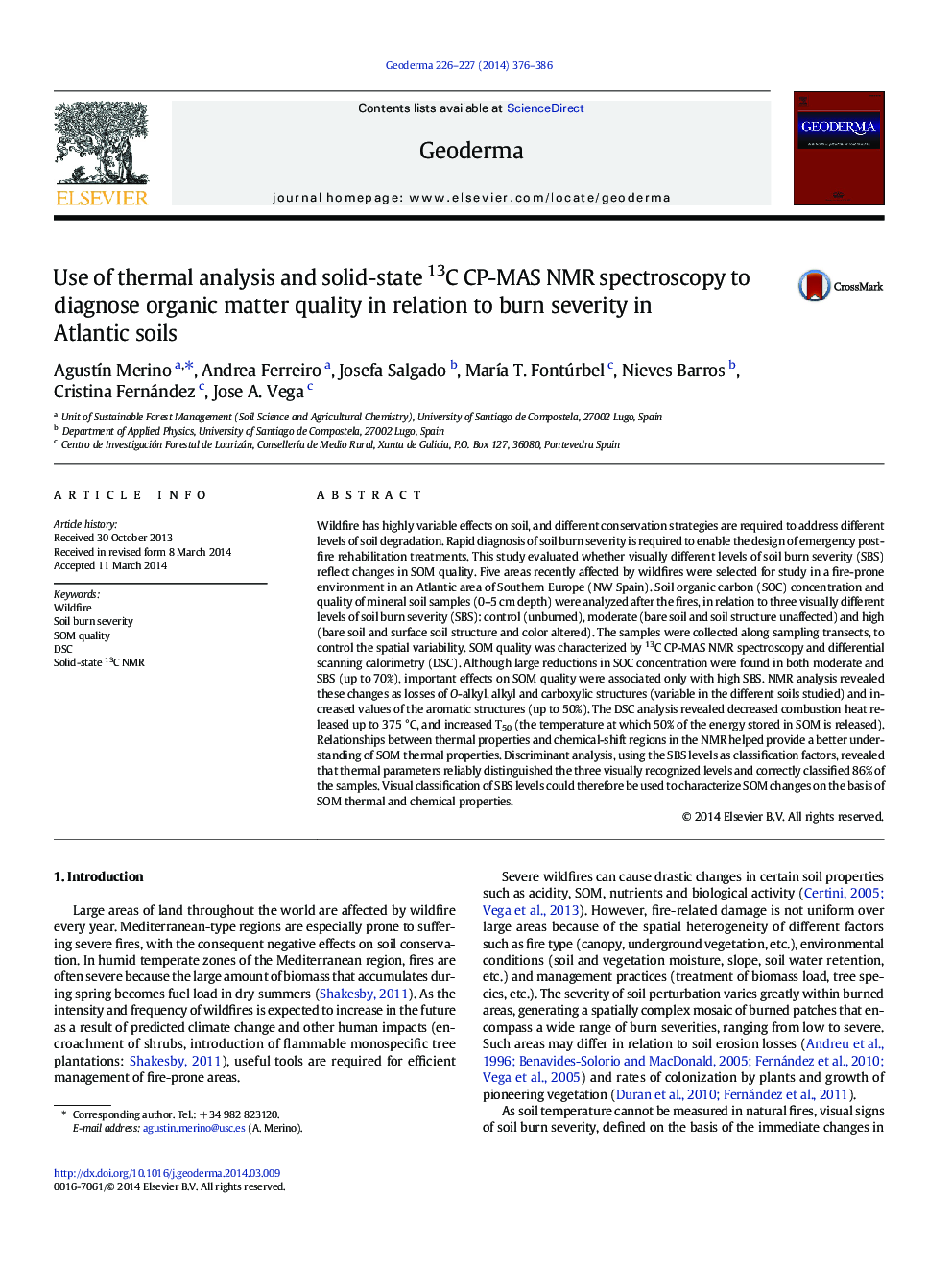| کد مقاله | کد نشریه | سال انتشار | مقاله انگلیسی | نسخه تمام متن |
|---|---|---|---|---|
| 6408900 | 1629472 | 2014 | 11 صفحه PDF | دانلود رایگان |
عنوان انگلیسی مقاله ISI
Use of thermal analysis and solid-state 13C CP-MAS NMR spectroscopy to diagnose organic matter quality in relation to burn severity in Atlantic soils
دانلود مقاله + سفارش ترجمه
دانلود مقاله ISI انگلیسی
رایگان برای ایرانیان
کلمات کلیدی
موضوعات مرتبط
مهندسی و علوم پایه
علوم زمین و سیارات
فرآیندهای سطح زمین
پیش نمایش صفحه اول مقاله

چکیده انگلیسی
Wildfire has highly variable effects on soil, and different conservation strategies are required to address different levels of soil degradation. Rapid diagnosis of soil burn severity is required to enable the design of emergency post-fire rehabilitation treatments. This study evaluated whether visually different levels of soil burn severity (SBS) reflect changes in SOM quality. Five areas recently affected by wildfires were selected for study in a fire-prone environment in an Atlantic area of Southern Europe (NW Spain). Soil organic carbon (SOC) concentration and quality of mineral soil samples (0-5 cm depth) were analyzed after the fires, in relation to three visually different levels of soil burn severity (SBS): control (unburned), moderate (bare soil and soil structure unaffected) and high (bare soil and surface soil structure and color altered). The samples were collected along sampling transects, to control the spatial variability. SOM quality was characterized by 13C CP-MAS NMR spectroscopy and differential scanning calorimetry (DSC). Although large reductions in SOC concentration were found in both moderate and SBS (up to 70%), important effects on SOM quality were associated only with high SBS. NMR analysis revealed these changes as losses of O-alkyl, alkyl and carboxylic structures (variable in the different soils studied) and increased values of the aromatic structures (up to 50%). The DSC analysis revealed decreased combustion heat released up to 375 °C, and increased T50 (the temperature at which 50% of the energy stored in SOM is released). Relationships between thermal properties and chemical-shift regions in the NMR helped provide a better understanding of SOM thermal properties. Discriminant analysis, using the SBS levels as classification factors, revealed that thermal parameters reliably distinguished the three visually recognized levels and correctly classified 86% of the samples. Visual classification of SBS levels could therefore be used to characterize SOM changes on the basis of SOM thermal and chemical properties.
ناشر
Database: Elsevier - ScienceDirect (ساینس دایرکت)
Journal: Geoderma - Volumes 226â227, August 2014, Pages 376-386
Journal: Geoderma - Volumes 226â227, August 2014, Pages 376-386
نویسندگان
AgustÃn Merino, Andrea Ferreiro, Josefa Salgado, MarÃa T. Fontúrbel, Nieves Barros, Cristina Fernández, Jose A. Vega,